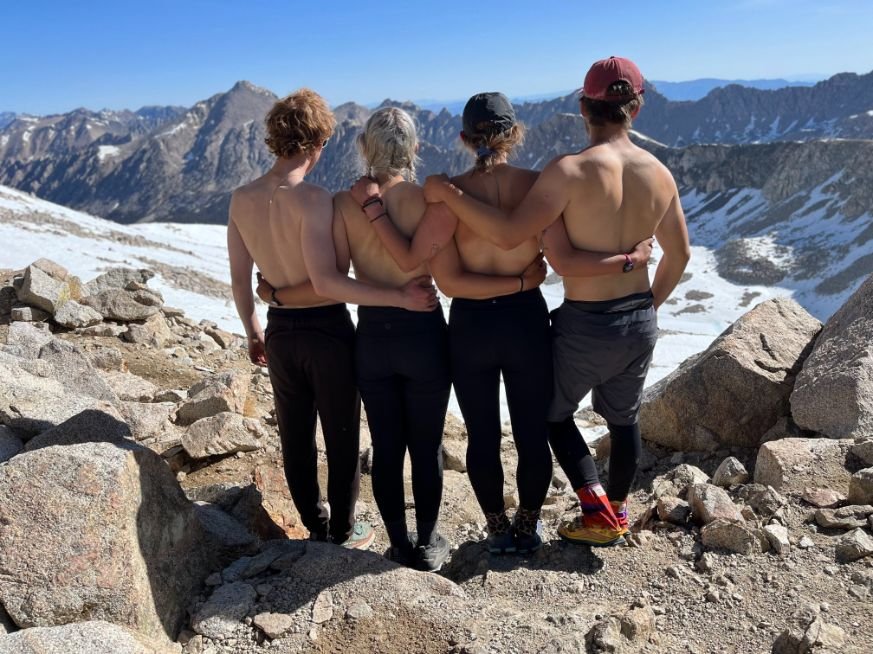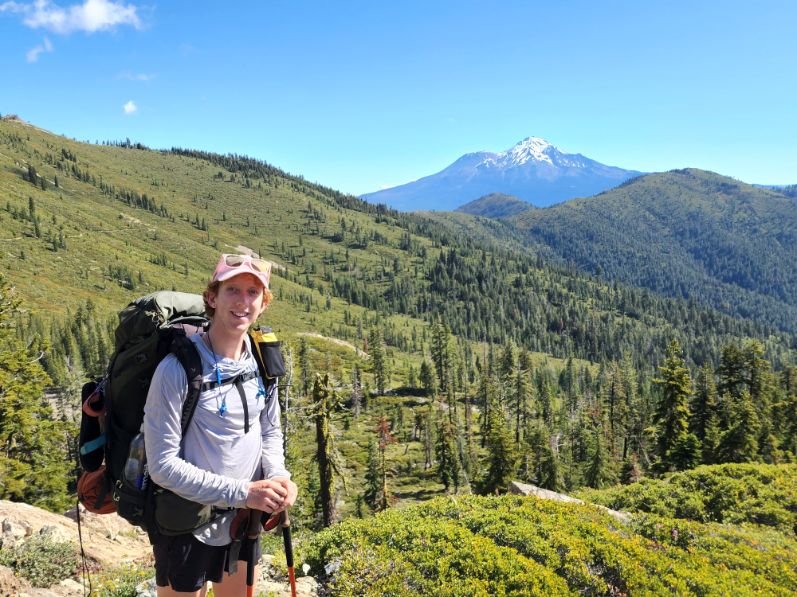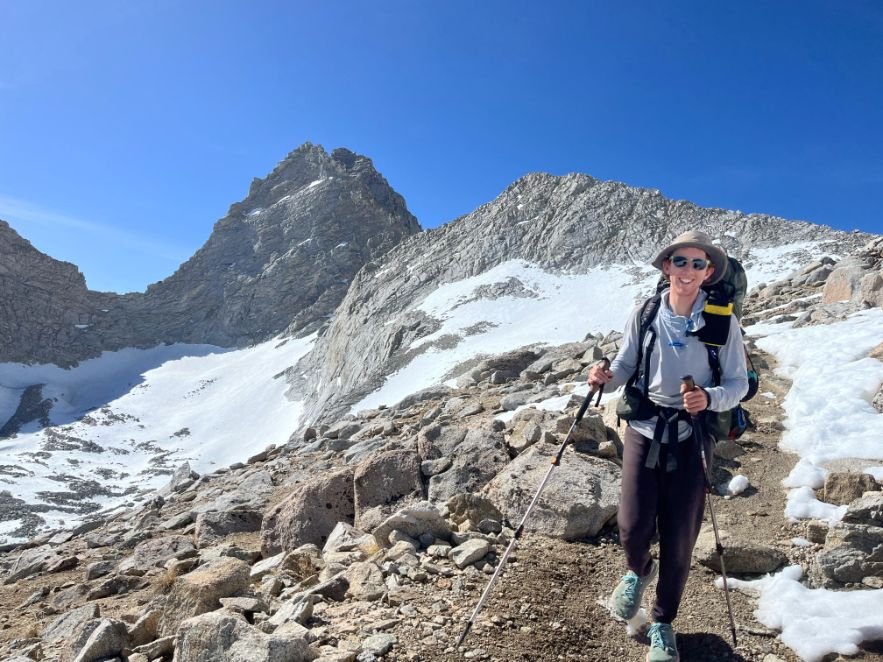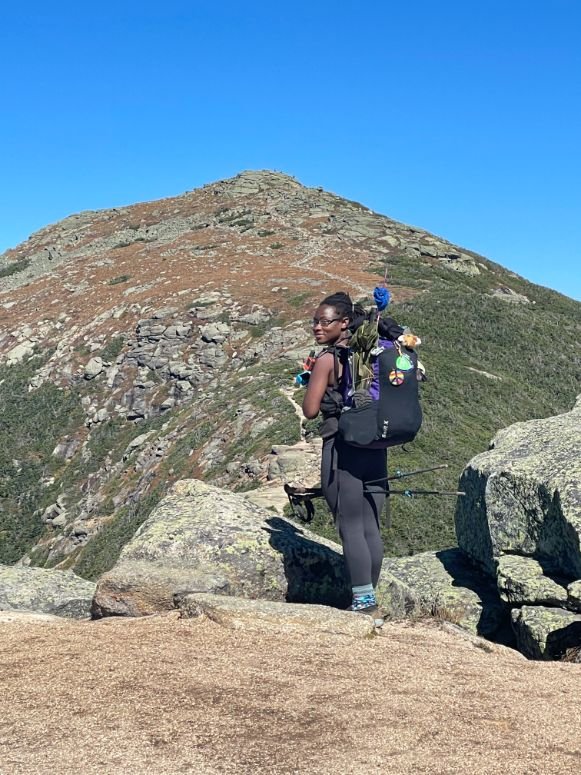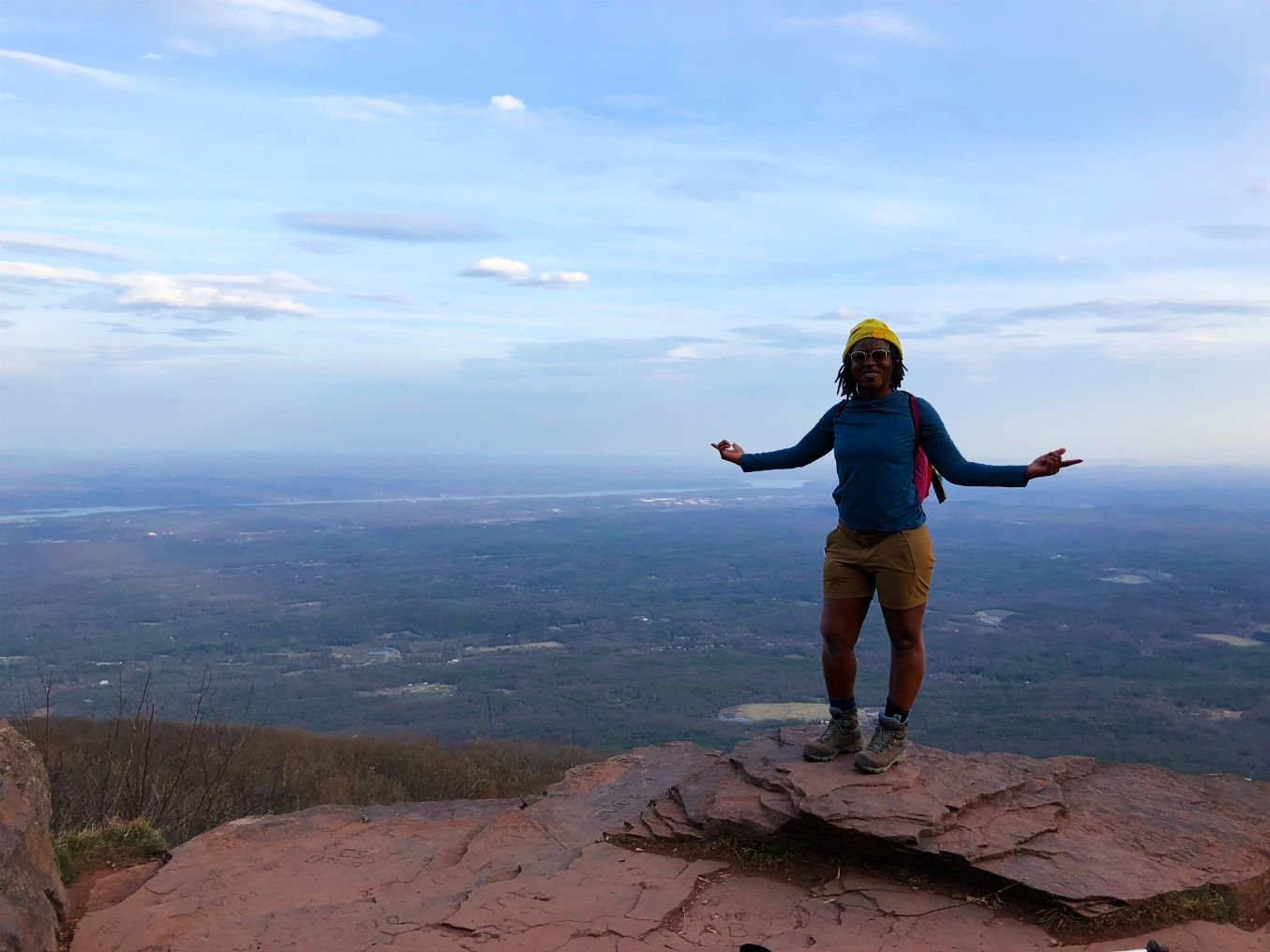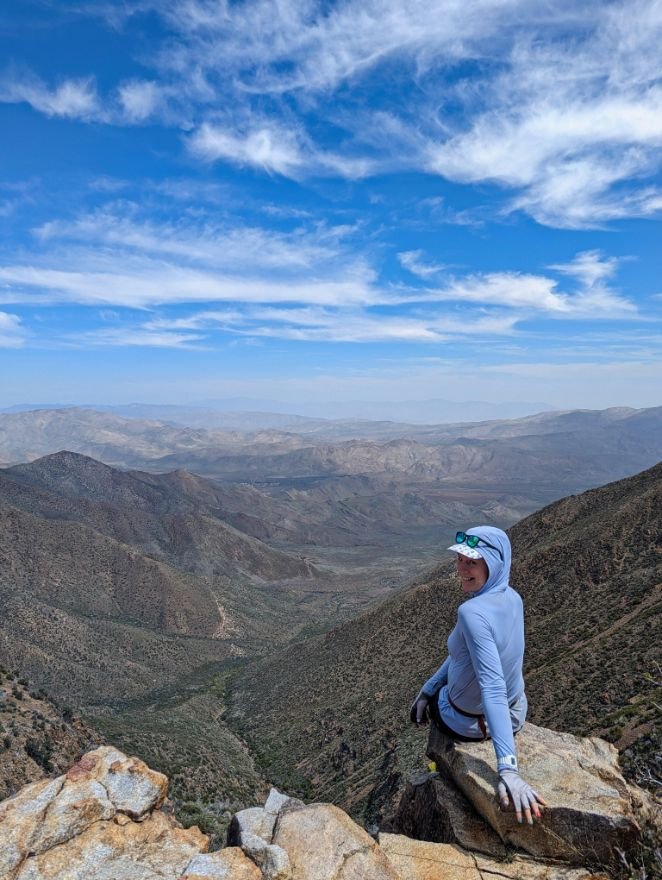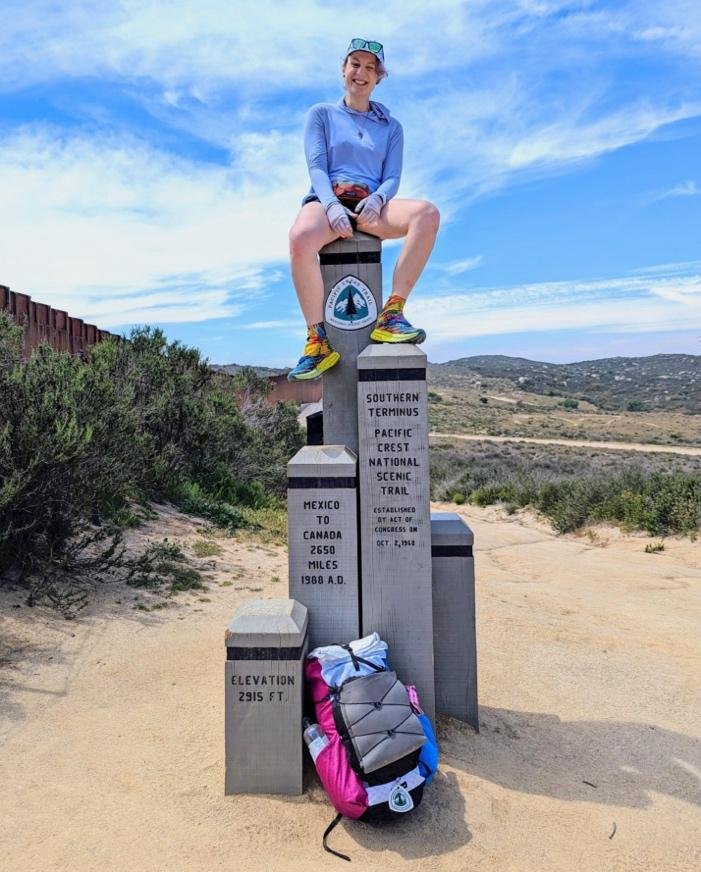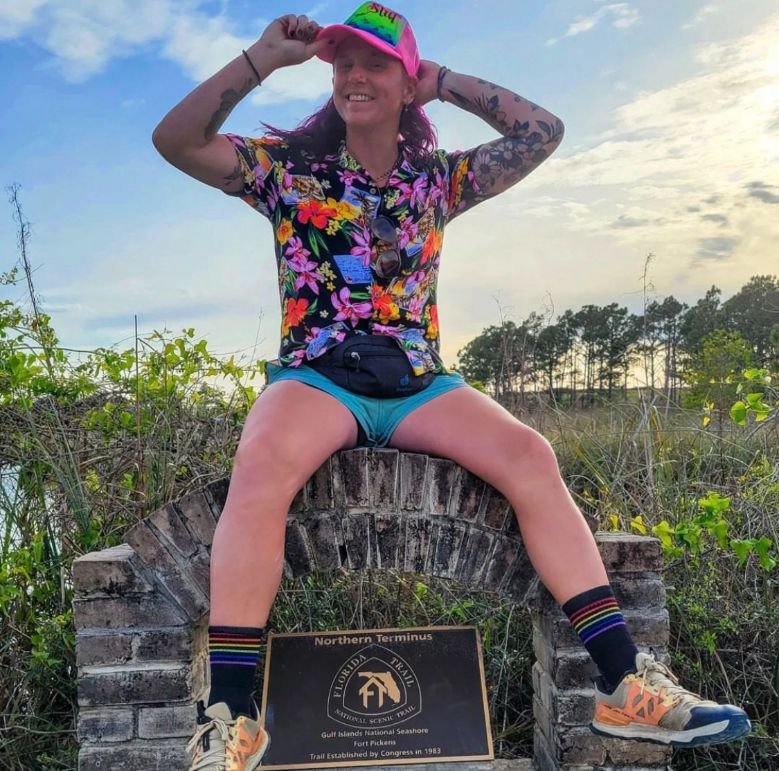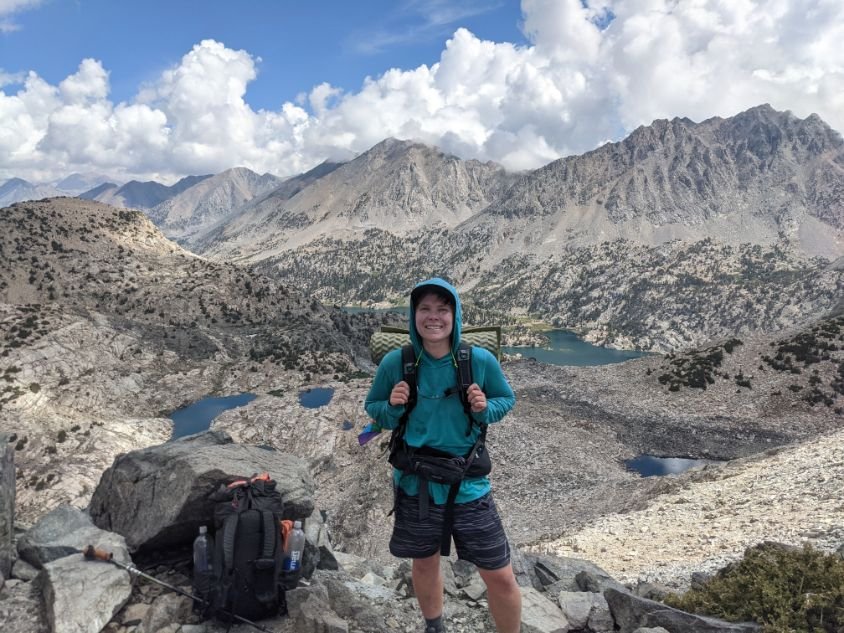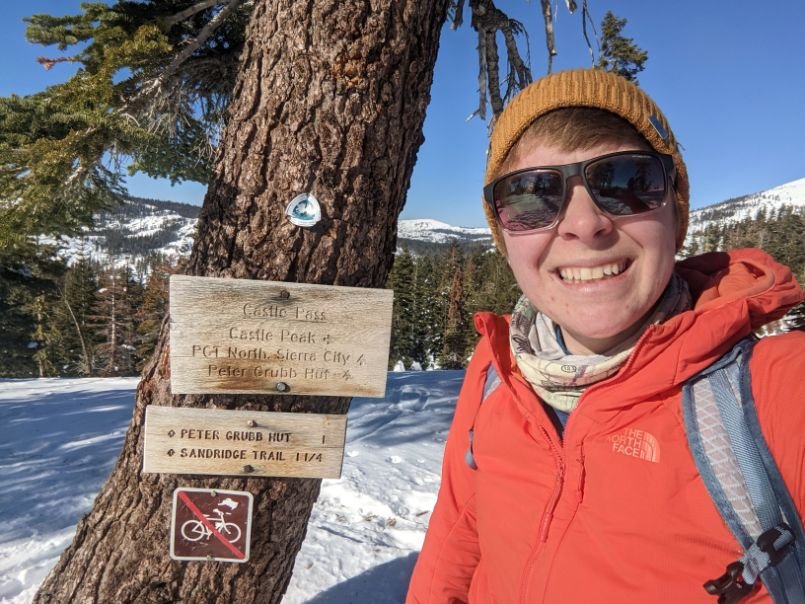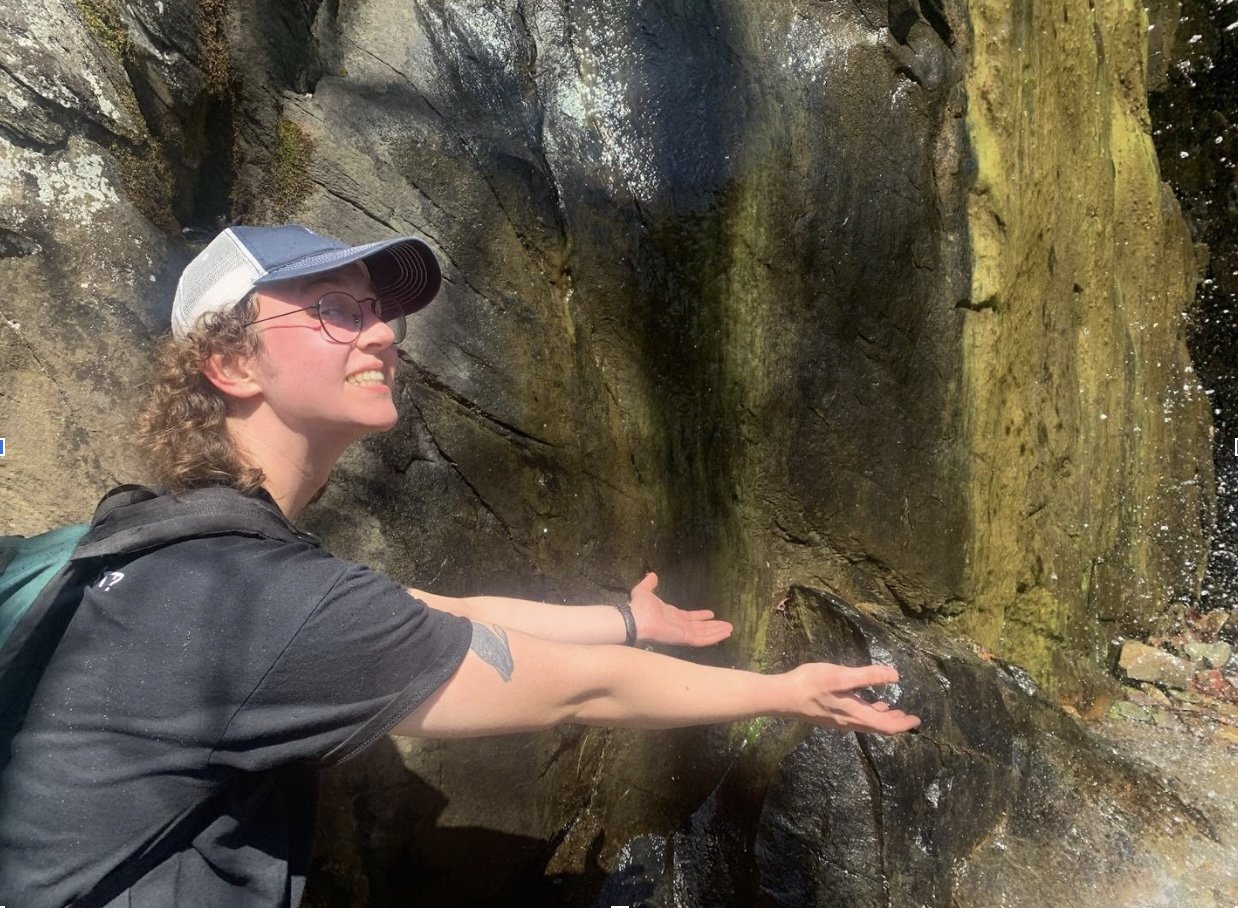How to Thru-hike as an LGBTQ+ Person
Six LGBTQ+ thru-hikers share why they hike and their advice for LGBTQ+ people on the trail
Bubbles!!! and her queer trail family on top of Forester Pass, the highest point on the PCT in the Sierra Nevada Mountains, May 2022.
The outdoors is a place of freedom from the constraints of everyday life for many of us, including LGBTQ+ people. For queer people especially, the outdoors is a place where one can practice authenticity in a setting that’s removed from everyday life and societal constraints on self-expression.
As I began to think seriously about my first thru-hike, I wondered about all the usual things a first-time thru-hiker does—but also about personal safety and expression as a queer person on the trail. I found a few Reddit threads and articles about the experiences of queer and transgender people on the Appalachian Trail, but I was curious about the experiences of other LGBTQ+ people on long trails, especially considering the recent anti-LGBTQ+ bills passed in certain states. I wondered what I would need to prepare for or whether it would even be possible to live authentically on the trail.
I reached out to some incredible LGBTQ+ thru-hikers because I wanted to know more. How did they get into the outdoors? What makes them feel drawn to nature? What is the nature of hiking a long trail as an LGBTQ+ person, and what did they do to stay safe?
Here’s what they had to say.
Meet Ciaran “Bubbles!!!” Young (she/her), Aubri “Data” Drake (they/them), Lyla “Sugar” Harrod (she/her), Dragonsky “Shilletha” Curtis (she/her), Laur Eliza “Cheetah” (any/all pronouns), and Hazel “Platypus” Platt (he/him), six fabulous LGBTQ+ hikers who are total badasses on and off the trail.
We create reader-supported, objective gear reviews independently selected by our editors. This story may contain affiliate links, which help fund our website. When you click on the links to purchase gear, we may get a commission — without costing you an extra cent. Thank you for supporting our work and mission of outdoor coverage for every body! Learn more.
Ciaran “Bubbles!!!” Young she/her
Bubbles!!! in Northern California with Mt. Shasta in the background.
For lifelong hiker and transgender woman Ciaran “Bubbles!!!” Young, thru-hiking the Pacific Crest Trail was a gender-affirming experience. She says, “Without being constantly gendered by others and my reflection, because you'll never see yourself, I was stripped down to only how I viewed myself and what felt right within my head. I felt I found a feminine persona there and came to identify strongly with that internal self.”
Young has hiked throughout the United States in the Northeast and the Cascades out west. Nature and being outside in the natural world, she says, are the closest thing to a religion that she has.
“Bubbles!!!” walking down from Forester Pass.
When you’re out hiking, Young says, gender and gender roles tend to fizzle out for everyone. In her experience, we all become sort of “non-binary, androgynous, dirty creatures” and not exactly human—a unifying element to the trail. Being in the woods can desensitize hikers to certain social norms, and “humanity kind of goes away until you go into town.”
Poignant gender-affirming moments have occurred for Young on her hikes. On her Pacific Crest Trail journey, she realized that she was the result of countless people projecting gender onto her. Out there, without people's constant input, she realized that “when you don't have people telling you what you are, you get to figure out what you actually are.”
Bubbles!!! and tent below Mather Pass in the Sierra Nevada in May 2022.
On the trail, she says that she carried a “town dress,” which she recommends to everybody, regardless of your gender. Wearing it in town was more than just a way to have something to wear while doing laundry—it was one of the little ways she practiced gender affirmation during long hikes.
The magic of the trail even has a way of bringing queer people together in chance encounters, regardless of if they set out together. You get to know people quickly when you meet them; even if you move on quickly too, they become part of your network. In her experience, there’s so much love and community with the people you meet. “And,” she adds, “that is as valuable as all the sites and beautiful nature you’ll see.”
The ability to decide who you hike and spend time with—and the ease of connecting with others on the trail—gives you the privilege of choosing your trail family. You get to stick with the people who make you feel your best and bring out the best in you. And, she says, it’s well worth it to stick it out for those people.
“Don’t tolerate any kind of bigotry. Don’t tolerate people being shitty,” says Young. Hike your own hike applies to queer people as well as anybody.
Bubble’s trail log:
Pacific Crest Trail (2022)
Section hikes of the Northeast Appalachian Trail
Follow along:
Instagram: @coppertopwalk
Aubri “Data” Drake they/them
Data in Yosemite/Tuolumne Meadows in July 2022 at the end of a 750-mile PCT section hike.
Not from a particularly outdoorsy background, Drake began hiking once they started medically transitioning and no longer felt safe at the gym. When they were growing up, their family considered hiking bizarre.
But for Drake, after discovering a running area near where they worked, the outdoors became a place of self-discovery and affirmation.
“I was running there all year round, watching the seasons change in the same place and the animals there. And I would be the only person there in winter,” Drake says. When everything in their life felt scary and unmoored, and nobody saw them for who they were, going running and being part of nature and the changing seasons affirmed how natural they were.
Data on the John Muir Trail/Nüümü Poyo in the Sierra (CA) in August 2022.
About a year later, they did the Massachusetts Appalachian Trail for the first time—alone.
On the last day of this intense hike, it was so clear that they could see the entire distance that they had hiked—76 trail miles. Seeing the distance they had covered on their own with their eyes, carrying everything they needed on their back, brought a profound feeling of awesomeness around their power.
The outdoors is a transformative outlet for self-discovery and coming into one’s own. Drake says that for them, the outdoors was a place of “second adolescence” and a coming-of-age experience as they realized their actual gender and sexuality. It felt both empowering and authenticating.
Data on the John Muir Trail/Nüümü Poyo in the Sierra (CA) in August 2022.
Hikers tend to have a “live and let live” attitude most of the time, Drake says. But in terms of personal safety on the trail, deciding when you want to be explicitly out is an aspect of how they stay safe. While they often wear a hat with a rainbow moose on it, it is something that they can take off when they so choose, such as in town or when trying to get a hitch.
They also play “pronoun games,” as many queer people do in uncomfortable situations. For example, while not outright misgendering their friends or partner, they can choose not to specify gender or avoid using pronouns altogether, depending on the scenario.
Further, Drake suggests that for people—especially trans people—who are concerned about having to deal with an unknown person or clinic that won’t necessarily understand their body or gender, it could be wise to get prescriptions for particular medications filled ahead of time, such as UTI meds or Hormone Replacement Therapy (HRT). Or, alternately, set up a way to have friends or family pick up medications at home and then help you get them if you’ll be out longer than medications will last.
Certain types of HRT, including testosterone, are controlled substances. Different states have different rules about dispensing controlled substances and pharmacies may refuse to fill scripts. That said, if you plan ahead it is still possible to get your medications on the trail, as Drake has done on a variety of trails.
One of the main things Drake thinks is worth reminding people is that you can get a long hike experience by taking a week or two off work. “That is just as valid an experience in the woods.”
data’s Trail log:
Currently hiking the Arizona Trail in a calendar year (March-October, 2023)
Section-hiking the Pacific Crest Trail (2019-2023)
Section-hiked the John Muir Trail (2021-2023)
Cohos Trail (2021)
John Muir Trail (2019)
Tahoe Rim Trail (2019)
Tour du Mont Blanc (2018)
Section-hiked the Vermont Long Trail (2013-2018)
Section-hiked the Appalachian Trail (2013-2017)
Section-hiked the New England Trail (2011-2016)
Follow along:
Instagram: @genderqueer_hiker
Blog: https://transcendingmountains.blog/ where you will find Hiking Advice Articles and Gender-Related Articles
Dragonsky “Shilletha” Curtis she/her
Dragonsky in the White Mountains, New Hampshire.
For Dragonsky “Shilletha” Curtis, the outdoors was not always present in her life. Like so many others, losing her job at the outset of the pandemic led to a loss of stability. Living in northern New Jersey, which was largely shut down then, Curtis needed an outlet.
With this came her lightbulb moment: “Somebody was like, ‘Why don’t you go outdoors?’ And I went outdoors because I heard so many people were outdoors during this time.” She went to Harriman State Park in New York, where a chance encounter with an older man on the path introduced her to the Appalachian Trail, which runs nearby. After she went home, she found she had “caught the AT bug” and decided to do it.
New to hiking, Curtis sought out and joined a North Jersey hiking group which she found was a great way to meet people, get experience hiking, and learn some tricks of the trade.
But her preparation for her AT trip quickly changed in tone. Later in the summer of 2020, Ahmaud Arbery was murdered while jogging in Georgia. This sparked fear in her as a Black gay woman, given that the trail she had been training to do starts in Georgia. She began to wonder, “Should I do this? Is this really for me?”
Dragonsky mountaineering with a view.
In the days following, Dragonsky sought advice from people knowledgeable about the AT regarding her safety as a Black gay woman on the trail. Instead of advice, however, she was told that she was causing division by bringing race into the conversation and to keep politics out of the group.
In response to the backlash, she wrote an article about her experience which indicated the barriers to the outdoors for people of color, specifically Black people. Despite its jarring nature, the experience was a catalyst for her. She was resolved to be the first person who hikes alone “as a gay Black woman, to stand on my own two feet and show the world that I could do this. And show myself, most importantly, that I can do this.”
“That’s how I became Dragonsky,” she says—by turning her pain into power. “Let’s talk about why [they] think my race doesn’t matter in these woods, especially in the South and New England towns. Because those were the towns where I experienced the most racism.”
People of color face additional obstacles in the outdoors, she states. “If you don’t have to check your skin before you go into town, just remember you have a privilege.”
Dragonsky is determined to be her true self in the woods. Her whole life, she felt that she had to suppress herself, but on the trail, she decided she was not willing to do that. In the woods, in fact, she says she accepted herself as a part of the animal kingdom. She says, “I am nature; how dare you mess with me here? I’m going to be who I am.”
She even hikes with a rainbow tutu during Pride Month. While she got some dirty looks from a few other hikers, when asked why she was wearing her tutu or a rainbow patch, she would just respond, “Because I’m fabulous.” The tutu is a way she shows others that she is out and proud—something that can’t be taken away.
Overall, though, Dragonsky says people always look out for you on the AT, especially if you’re LGBTQ+. When a member of the Proud Boys was on the trail at the same time as her, the information spread down the trail quickly, and people warned her to be careful in the area. The tiny percentage of people on the trail who are jerks “can go kick rocks,” but your fellow hikers will always be looking out for you just because it’s “just a phenomenal, phenomenal community.”
Dragonsky winter hiking in the Catskills.
dragonsky’s trail log:
Appalachian Trail, 2021
Half of the Continental Divide Trail, 2023
Follow along
YouTube: @i_am_dragonsky
TikTok: @i_am_dragonsky
Instagram: @i_am_dragonsky
Laur Eliza “Cheetah” any/all pronouns
Cheetah two miles from Eagle Rock, post-washing up in a stream after a long and dusty day of hiking, April 21st, 2023.
“I was in my dad's backpack as a toddler up in the mountains. I grew up in Southern Bavaria where I could see the Alps from my backyard on good days,” says queer and trans hiker Laur Eliza. “So [I] very much grew up in an environment conducive to the outdoors.”
Eliza has always felt that they belong in nature– like that is where her body and brain belong. She is more comfortable outdoors than in cities or indoors, but not because it’s socially isolating or away from people. “It's more than just being in physical proximity in touch with nature. I love sleeping under the stars and feeling the dirt between my toes.”
But there was also a time when being in nature meant escaping social norms, pressures, and rules that didn’t work well for them. When her presentation was more incongruent with her identity, avoiding all these societal constraints was helpful. In nature, they found that “suddenly, nobody cares because nobody’s there, and the animals don’t give a shit.”
Practices for safety and comfort as a queer person on the trail depend very heavily on where Eliza is. Popular trails such as the AT and the PCT, he says, are, for the most part, very queer-friendly and safe at this point.
Laur Eliza on Mount Laguna on the PCT, April 17th, 2023.
While the discussion of queer inclusion and safety is still important, Eliza says, in their experience, they generally haven’t felt excluded from outdoor spaces. She wishes there would be a bigger focus on racial diversity in these spaces.
“At this point in my transition, I need to out myself if I want to be known as queer,” they say, “I can very easily just pass as a cis person, and you don't really see my sexuality unless I'm with my partner or express it somehow.”
Cheetah at the 100-mile-marker of the PCT, April 20th, 2023.
Being intentionally visible as a queer person means deciding when and where you want to be out, which is a different experience from being visibly queer. Eliza is very vocal about their transness on the trail, noting that she wasn’t trying to be stealth. “But it’s obviously very different just being inherently seen as queer and always able to out yourself.”
Cheetah enjoying a favorite hiker town food — pizza!
In sharing her experiences, she touches on often undiscussed aspects of hiking while trans. For example, shaving on the trail can be a complicated topic for trans women, as is dealing with Hormone Replacement Therapy (HRT) injections. Experiences of injecting and shaving are things that distinguish her journey from other people’s. For Eliza, treating these intricacies normally is important. They say being explicit and casual about sharing these experiences shows “it’s not a big deal.”
Laur Eliza and pack at the Southern Terminus of the PCT, April 12th, 2023.
Cheetah’s Trail Log:
Pacific Crest Trail, Miles 0-150 (2023)
North Country Trail, Michigan Section (2022-23)
Bruce Trail, Bruce Peninsula Section—Canada (2020)
GR 221—Spain (2019)
E4, Pennepolese Section—Greece (2018)
Padjelanteleden—Sweden (2018)
Maler Weg—Germany (2016, 2017 & 2018)
Országos Kéktúra, North Section—Hungary (2016)
Follow along:
Instagram: @elizawalksabunch
Twitter: @itslaureliza
Carrd: @justlaur
Lyla “Sugar” Harrod she/her
Lyla “Sugar” Harrod in the Cascades, July 2022
Growing up in the suburbs, Lyla “Sugar” Harrod spent a lot of time outside but didn’t start truly hiking until she lived in Seattle during her 20s. Then, she discovered hiking in the Cascades and the Olympic Mountains, which she describes as two of the most gorgeous mountain ranges on the planet.
Harrod continued hiking on the East Coast, but it wasn’t until she got sober at age 30 that she found the time and mental capacity to get into it. Coming out as transgender a year later was the next part of her two-year transformation. And with this transformation, her love of hiking and backpacking deepened.
During the early days of the pandemic, Harrod fell in love with the idea of the adventure of thru-hiking and the connection to the outdoors that she was forming. She decided to hike the Appalachian Trail in 2021.
Harrod ties the recent bloom of trans and queer visibility in the thru-hiking world to a possibility model. “If you don’t know it exists, how do you know you can be it?” But Harrod says that trans people have existed outdoors this whole time, even if they weren’t visible. Her feeling of loneliness and isolation as a trans hiker, she says, was “truly unwarranted.”
Sugar at the Northern Terminus of the Florida Trail in March 2023.
Thru-hiking, especially on trails like the AT, has isolating and social aspects, which can be a beautiful way to connect with yourself—and others—through nature. Harrod says many people hit the long trails to break out of the shell of who they were, to reinvent or become a new version of themselves. Thru-hikes are an excellent way for that metamorphosis to take place, and that’s why Harrod says it’s magical for a trans person to go out there and step into their authenticity.
In terms of keeping safe on the trail as a visibly queer person, Harrod says that situational awareness is a big part of her strategy. If you’re hitchhiking and you get into a stranger’s car, she says, and they misgender you, that might not be the time or place to have “an in-depth conversation about gender politics.”
Sugar on the Pacific Crest Trail in 2022.
Talking to people who come from a place of good faith is important, especially on the trail. Harrod is always happy to answer questions or engage with people who are curious about topics like sexuality, gender, and identity; and has found that the vast majority of people do have the best of intentions.
Her attitude going into difficult conversations is that we all share something when we’re outdoors. She says that thru-hikers tend to respect one another, regardless of who they are or where they come from. She treats this understanding as a starting point and tries to come from this place of open-mindedness when meeting new people on the trail.
Having this type of conversation is something you get used to doing, Harrod says, like throwing yourself into the gym to work out every day. “That being said, I don’t think it’s smart for people to step so far outside their comfort zone that they don’t feel safe or they don’t feel like they’re being effective.” She adds, “If you are so nervous about your physical safety that you’re unable to focus on the conversation and really be present and authentic for them, then don’t have the conversation.”
Sugar at the Mogollon Rim on the Arizona Trail, 2021.
It's not a requirement for queer or trans people on the trail to offer their time and emotional labor to help others understand them. But for her, doing so is a choice she makes whenever possible. “Those one-on-one conversations are where change happens,” says Harrod.
Related: Our Favorite PCT Gear
Trail log:
Set the Women’s Unsupported Fastest Known Time for the White Mountains 48-Footers, or the “White Mountains Direttissima” (2022)
Pacific Crest Trail (2022)
Hayduke Trail (2022)
Appalachian Trail (2021)
Arizona Trail (2021)
Bay Circuit Trail (2021), set the Self-Supported Fastest Known Time for the BCT
Follow along:
Instagram: @seltzerskelter
Hazel “Platypus” Platt he/him
Platypus on Glen Pass on the PCT, August 2022.
A former web developer, Hazel “Platypus” Platt, was driven to the outdoors by feeling trapped in his job, like there was more to see in the world. At 23, having never been into hiking or backpacking, he left his job to hike the Vermont Long Trail with a friend.
After going on a cross-country trip and seeing Yellowstone and Grand Teton National Parks, Platt was inspired, and his career pivoted. Following his Vermont Long Trail hike, he returned to school for Recreation Park and Forest Management.
“I wanted to live a life where I would be in places like that,” Platt says. “So I kind of jumped really deep in, really quickly.”
Finding community on the trail is a major part of how Platt stays safe and comfortable in unfamiliar territory. Platt says there are more queer people in the hiking world than you think. Sometimes you just have to do a little legwork to find them.
Backpacking the High Sierra on the Big Sequoia/Kings Canyon loop, August 2022
On his first thru-hike on the Appalachian Trail, Platt wasn’t sure what to expect, as he wasn’t out to many people then. But by the end of his time on the trail, he had a big group of queer people he was hiking with, making the whole experience “so much more enjoyable.”
Platypus in the field with a crosscut saw as a West Virginia wilderness ranger in 2020.
The feeling of freedom in nature resonates deeply with Platt and is integral to his attitude as a thru-hiker. He suggests avoiding getting caught up in hyper-specific expectations around doing your hike in a certain way or proving the legitimacy of your hike to other people.
Platt doesn’t think there’s a single right way to backpack. “There is a wrong way to backpack for sure,” he says, but there are a million right ways, depending on your goal. As long as you respect the trail and the people around you, you don’t have to take it so seriously.
Snowshoeing on the PCT near Castle Peak, December 2022.
Platt says having that space for contemplation on the trail helped him come to terms with himself and even inspired him to come out. The space to be himself and the realization that it’s his life to live, afforded to him by nature, have been critical parts of his journey as a queer person.
“It’s all about having that space to connect with yourself,” he says. “Nature is somewhere you can be free of many of the expectations that come along with just existing in society.”
Trail Log:
Appalachian Trail 2019
Pacific Northwest Trail 2021
Various sections and shorter trails
Links:
Instagram: @ranger.plattypus
AUthor’s reflection
I have long loved nature and being outdoors. Like many of the people I talked to for this article, I experience a sense of freedom in nature and relate to the feeling of being as natural as the nature around me when I’m outdoors.
Especially when I was coming to terms with my queer identity, being able to just escape into the woods was both necessary and beloved.
When one of my friends suggested that we do the Appalachian Trail after graduating college, I needed (almost) no time to be fully on board. It sounded like a dream come true in so many ways. But I had some trepidation about doing it as a queer person, especially going into unknown territory.
After talking to these incredibly fabulous and wise LGBTQ+ hikers, my trepidation has been replaced with inspiration. They showed me that not only is it possible for a queer person to do a long hike, but there’s a rich and vibrant community of LGBTQ+ hikers out there who look out for each other on the trail, from forming lasting friendships to keeping each other informed of any potential danger.
Heading into my Appalachian Trail journey, I feel excited about what lies ahead—and more prepared for whatever obstacles I’ll encounter along the way.
why you should trust us
Elliot Koeppel is an outdoor writer, here in Shenandoah National Park. Note bird tattoo on right arm.
Elliot Koeppel is a recent graduate of Tufts University with a B.A. in History. By the time you read this, he will have embarked on his first-ever thru-hike of the Appalachian Trail. For this article, he interviewed six LGBTQIA+ thru-hikers. In his free time, he can be found drawing, watercolor painting, making jewelry, listening to Van Halen, and acquiring tattoos of the sickest birds known to man.

